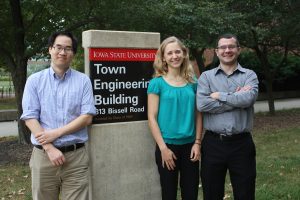
Construction, civil engineering faculty explore the art of problem solving to prepare graduates for real-world challenges on the job
Complex … these words describe the types of problems that Kristen Cetin knows engineers face on the job site.
“There’s no one solution,” she says, explaining the concept of ill-structured problems. “In addition to that, there’s other factors that come into account.”
Cetin is an assistant professor of construction engineering at Iowa State University (ISU) and the principal investigator of “Collaborative Research: Bridging the Gap Between Academia and Industry in Approaches for Solving Ill-Structured Problems.” She has received $300,000 in National Science Foundation (NFS) funding to explore how faculty can effectively mirror the complex problems of industry in the classroom.
“Since most students go into industry, it’s important that we as professors try to understand—and adapt to—that method of thinking,” Cetin says.
Starting in August 2017 and running through July 2020, Cetin and her team at ISU will examine the problem-solving approaches of students, professors and professionals. Team members include co-principal investigators Benjamin Ahn and Bora Cetin. Ahn is an assistant professor of aerospace engineering, and Bora Cetin is an assistant professor of civil engineering. Andrea Surovek, a research scientist and lecturer at the South Dakota School of Mines & Technology, will also collaborate with the team.
Cetin explains that factors complicating an engineer’s work life include conflicting or missing information, price restraints or scheduling restraints.
“The challenge is, once you go out and work in industry … most of the problems that you work with are not that structured,” she says.
A classroom provides its own restraints–mainly time and personnel. Ill-structured problems (problems where there can be multiple correct answers) are good ways to teach real-world engineering, says Cetin. The multiple solutions should mirror what a professional engineer may choose to do in the field. The catch lies in the large time commitment needed to grade and give constructive responses to these types of problems.
“The idea of this project is to try to understand how undergraduate students, seasoned industry professionals and professors solve an ill-structured problem,” Cetin says.
Within a controlled environment, individuals belonging to each of these three group–students, industry professionals and faculty members—will receive an ill-structured problem. Researchers will document each individual’s progress and process for solving the problem. They will also make notes of similarities and differences and ask questions of each individual’s process. At the end of the procedure, Cetin’s team will have recommendations and resources for improving the teaching of ill-structured problems.
“This project has the potential to not only inform future researcher studies in the area of complex problem solving in engineering contexts, but also for research findings to be translated to educational practice and implications to improve problem solving in undergraduate classrooms,” the researchers state in their proposal to the NSF.
Construction engineering graduate student Renee Flemming and undergraduate student Paige Taylor have contributed to this research.
Follow ISU CCEE on social media for the latest in innovative teaching techniques and research, including on Facebook, Twitter and LinkedIn (Iowa State University Civil, Construction and Environmental Engineering and ISUConE).
